

Some Bulgarian harvestmen.
Order: Opiliones, Harvestmen
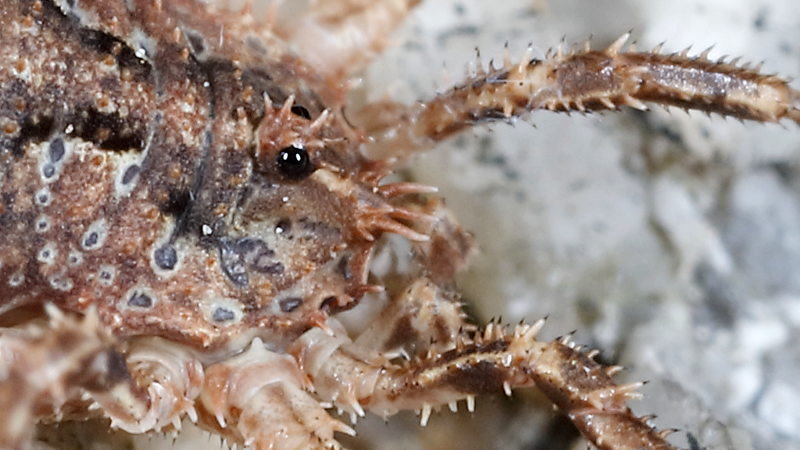
Lacinius horridus
Overview species:
- Family: Sironidae
- Cyphophthalmus spec.
- Family: Nemastomatidae
- Histricostoma drenskii Kratochvíl, 1958
- Paranemastoma aurigerum ryla (Roewer, 1951)
- Family: Dicranolasmatidae
- Dicranolasma .
- Family: Trogulidae
- Trogulus .
- Family: Phalangiidae
- Egaenus convexus (C.L. Koch, 1835).
- Lacinius dentiger (C.L. Koch, 1847).
- Lacinius horidus (Panzer, 1794).
- Metaplatybunus grandissimus (C.L.Koch, 1839).
- Odiellus lendli (Sørensen, 1894).
- Opilio ruzickai (Šilhavý, 1938).
- Opilio saxatilis C.L.Koch 1839.
- Rafalskia olympica bulgarica Starega, 1963.
- Zachaeus crista (Brullé, 1832).
Introduction:
In 2016, I took a butterfly photo trip to Bulgaria. That is, of course, the opportunity for me to look also at springtails and harvestmen. Back home with some pictures of harvestmen, the problem arose that I could not put their names on them. After a mail to the Bulgarian harvestman specialist, Professor Plamen Mitov, I got the names of the different harvestmen from Bulgaria. Only in 2022 will I manage to spend a week in Bulgaria again. Now with an encounter with Professor Plamen Mitov who has a nice surprise for me. He collected for me several species of live harvestmen and eggs of a Nemastomatidae. I have also found a few species. In Bulgaria, 57 species occur (Mitov & Stoyanov, 2004), so this site is still far from complete.
Family: Sironidae
This family of harvestman is very different from the other species. It is often reddish brown in colour. The eyes are missing
and it looks a lot like some kinds of mites.
On the prosoma there are two glands, with glandular openings (the ozopores), on either side, as in other harvestmen. Only in the Cyphophthalmi they sit on a conical elevation, ozophores.
Tests have been done with two French species in which a tarsus of the first leg is held with tweezers. After 10 to 15 seconds the animal responds by secreting a substance and applies it
with a tarsus from another leg to the attacker, in this case the tweezers. This behavior is called "leg-dabbing."
So it seems to be a defensive tool. The liquid has repellent properties in feeding trials with a different species of harvestman, an Odielles (Juberthie, 1961).
The composition of the substance of two species, Siro duricorius and S. exilis was examined by gas chromatography (Raspotnig, 2005).
A study of the excretion of the harvestman species Vonones sayi found that first a drop of water is secreted where the
contents of the glands are dissolved in. Only then a strong-smelling solution capable of repelling ants is produced (Eisner, 1971).
Males have a thorn (adenostyle) on the hind legs. In some species it is connected to glands, the composition of the secretion and the function of these glands is not yet known. Much clear information can be found on the English page of Wikipedia see bottom of this page (Wikipedia).
Cyphophthalmus spec.
The first three photos are of a specimen I found myself in SW Bulgaria. The other two photos are of specimens collected by Plamen Mitov. Most likely they are different (new) species.

Cyphophthalmus spec ♂ Arrow shows the adenostyle
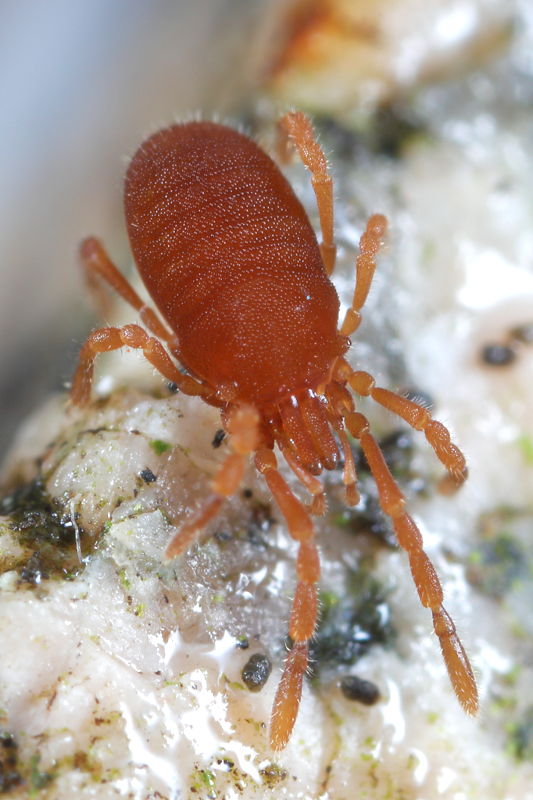
Cyphophthalmus spec ♂

Cyphophthalmus spec ♂

Cyphophthalmus spec ♀
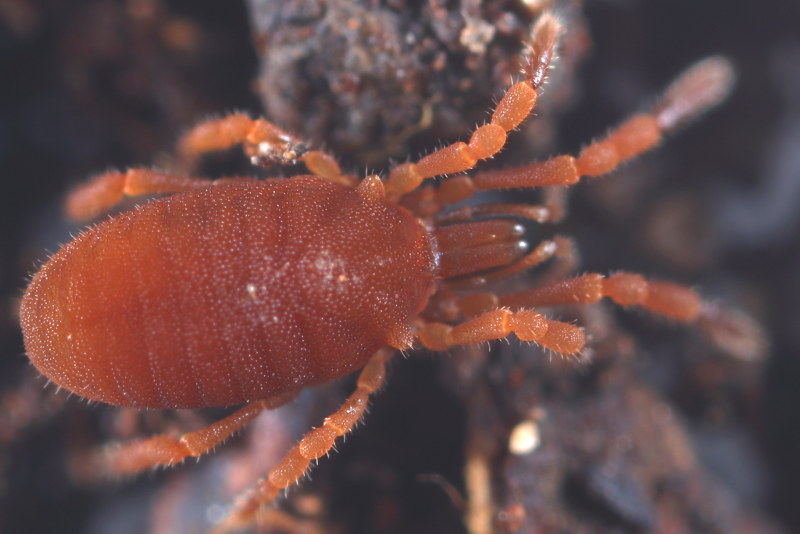
Cyphophthalmus spec ♀
Family: Nemastomatidae
Histricostoma drenskii
This is a very small and quick harvestman only a few mm in size. On the back, it has eight clear protruding spines. I took the photo from a live specimen collected by Plamen Mitov.

Histricostoma drenskii
Paranemastoma aurigerum ryla
Paranemastoma in Bulgaria is a difficult group, there occur according to (Starega, 1976) the following species and subspecies: P.aurigerum aurigerum, P.aurigerum ryla, P.aurigerum joannae, P.radewi and P.bureschi.. By Plamen G. Mitov Paranemastoma beroni was added in 2011 (Mitov. 2011). It is a new, eyeless species collected from the Stoykova Dupka 1 Cave in the Slavyanka Mountains (south-western Bulgaria). Most are endemic to Bulgaria. The species on the photo comes from Kyustendil and is Paranemastoma aurigerum ryla, one is a male, the other a female.
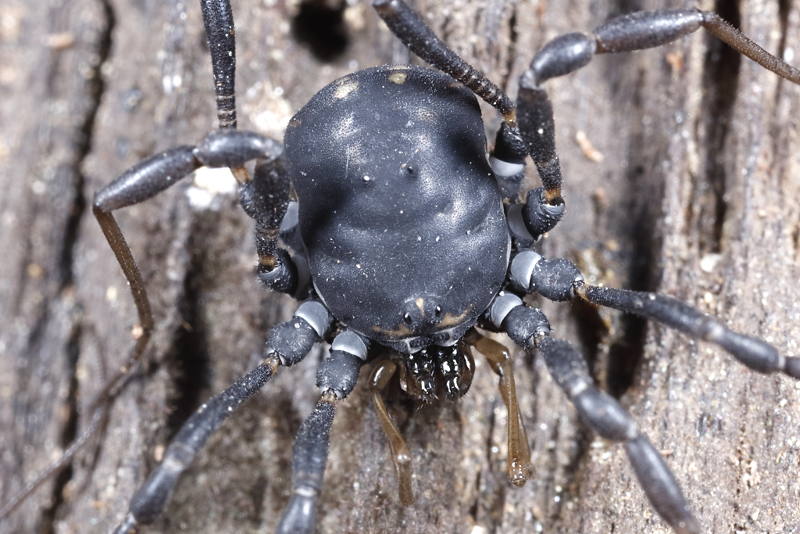
Paranemastoma aurigerum ryla ♂

Paranemastoma aurigerum ryla ♂
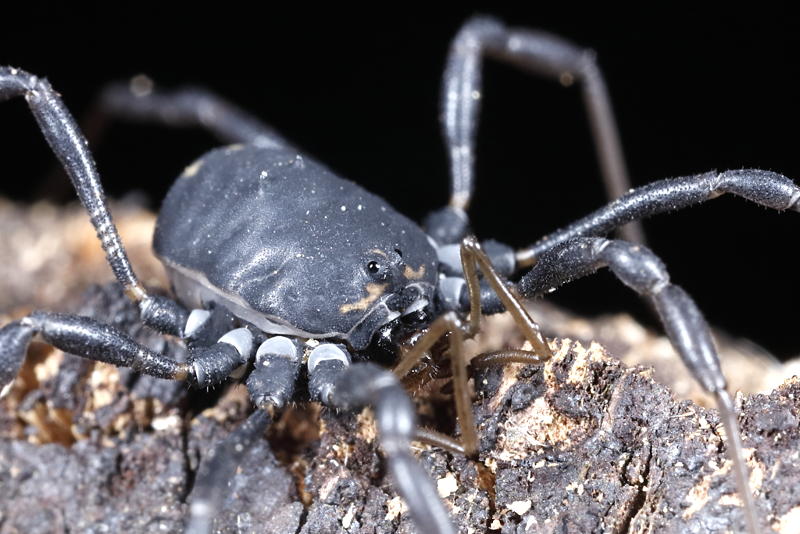
Paranemastoma aurigerum ryla ♂

Paranemastoma aurigerum ryla ♀

Paranemastoma aurigerum ryla ♀
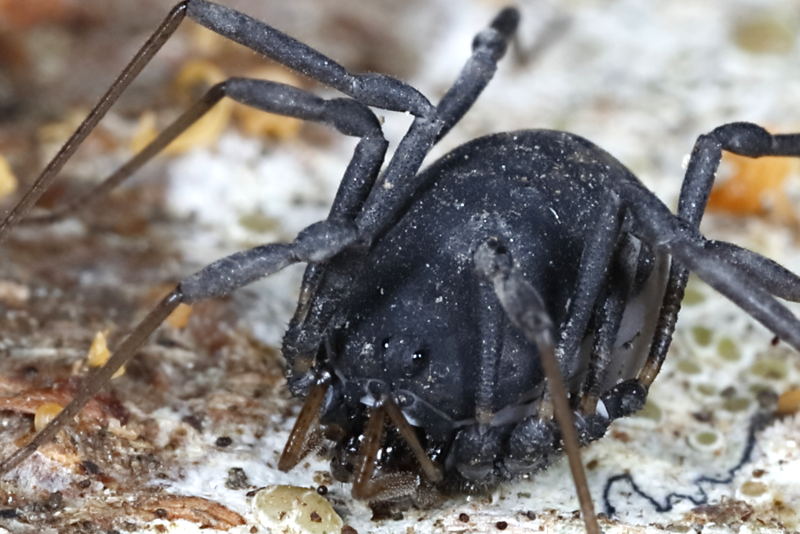
Paranemastoma aurigerum ryla ♀
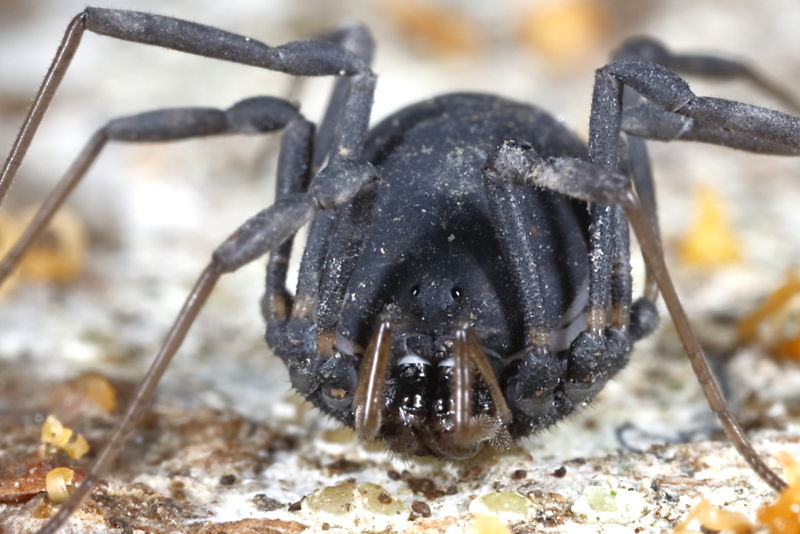
Paranemastoma aurigerum ryla ♀
The eggs of Paranemastoma species are deposited in a clump surrounded by a jelly-like mass. I took the photo from a clump of eggs collected by Plamen Mitov.

Paranemastoma eggs, Arrow shows the embryo.
Family: Dicranolasmatidae
Dicranolasma spec.
It is an animal that traps sand and other soil material on its body between protrusions and is so very well camouflaged. I took the photo from a live specimen collected by Plamen Mitov.

Dicranolasma spec.
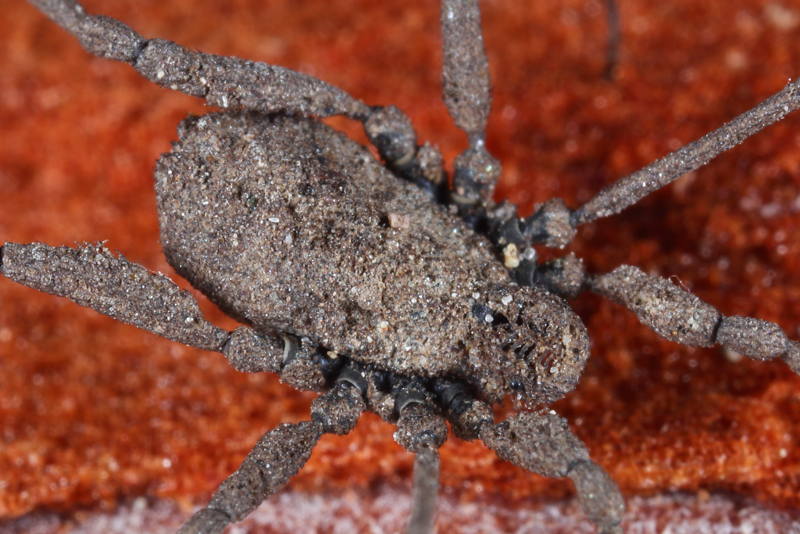
Dicranolasma spec.
Family: Trogulidae
Trogulus spec
It is an animal that traps sand and other soil material on its body between protrusions and is so very well camouflaged. I took the photo from a live specimen collected by Plamen Mitov.

Trogulus spec.

Trogulus spec.
Family: Phalangiidae
Egaenus convexus
Egaenus convexus is a very plump harvestman with rather short legs. The photos are of sub-adult specimens, they still have to moult one more time before they become adults. Then the white knees disappear.

Egaenus convexus ♀ subadult
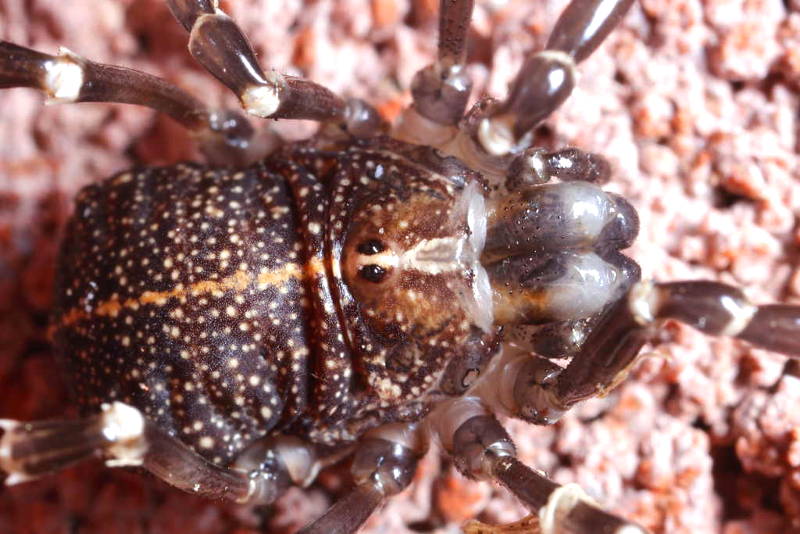
Egaenus convexus ♂ subadult
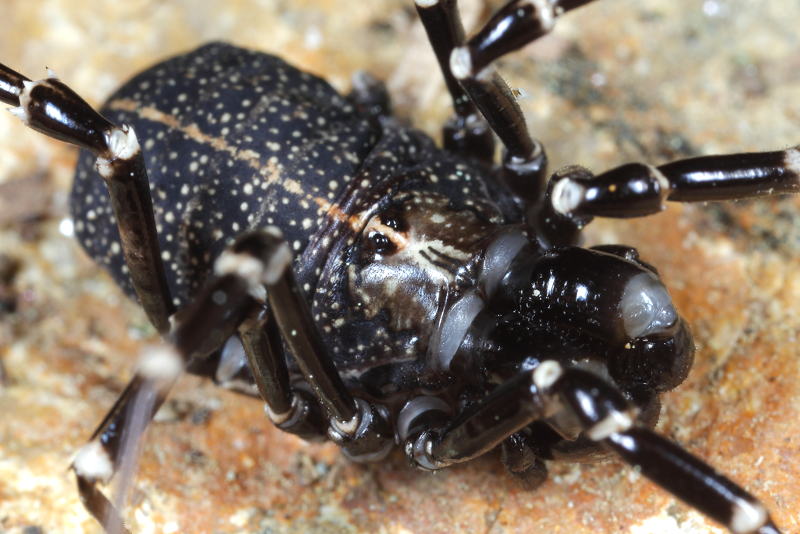
Egaenus convexus ♂ subadult
Lacinius dentiger
Lacinius dentiger is a harvestman expected it once also will pop up in The Netherlands. As far as the present distribution of the species is in fact extended that the beast is found in various places in Germany not far from The Netherlands. It's a beautiful harvestman where often also a greenish color on is and lots of short spines on the body. Je vindt deze soort vaak op muren en op kale rotswanden. These animals I found many in Bulgaria. The females are up to 9.2 mm, males up to 6.6 mm.
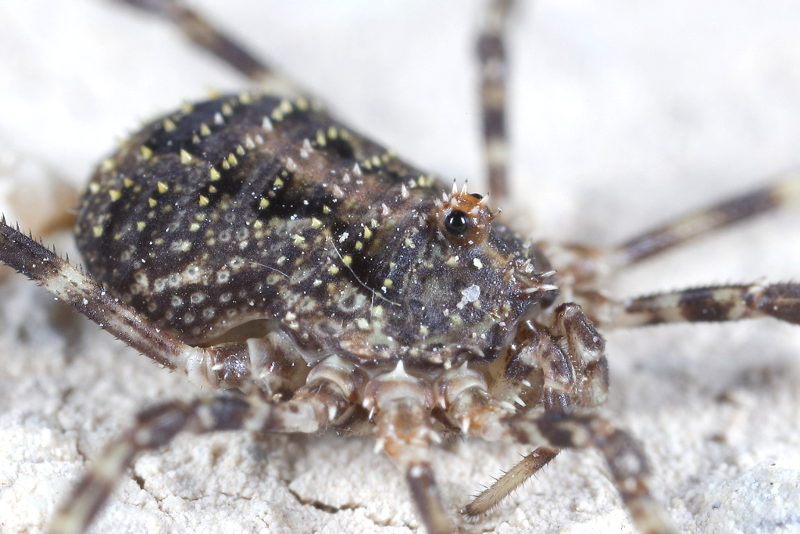
Lacinius dentiger
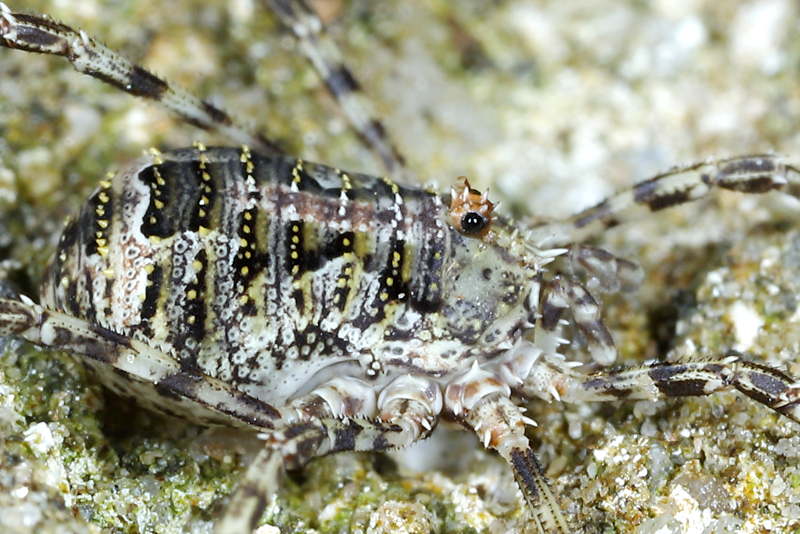
Lacinius dentiger

Lacinius dentiger
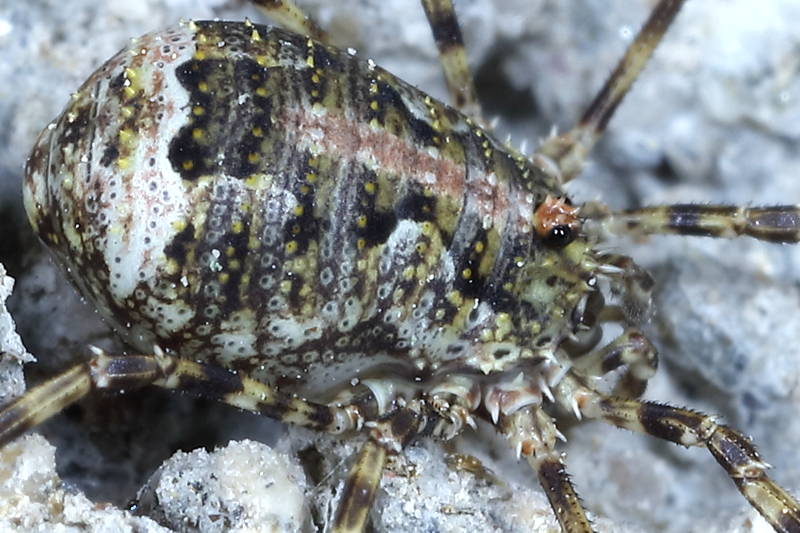
Lacinius dentiger
Lacinius horridus
Lacinius horridus Looks a lot like the previous species but has many more and longer spines also on the legs. Of this kind I found but one specimen on a large boulder in a field with low vegetation. They are animals that can stand the heat. The females are up to 6,9 mm, males up to 4.6mm. This species is also to be expected in the future in The Netherlands.
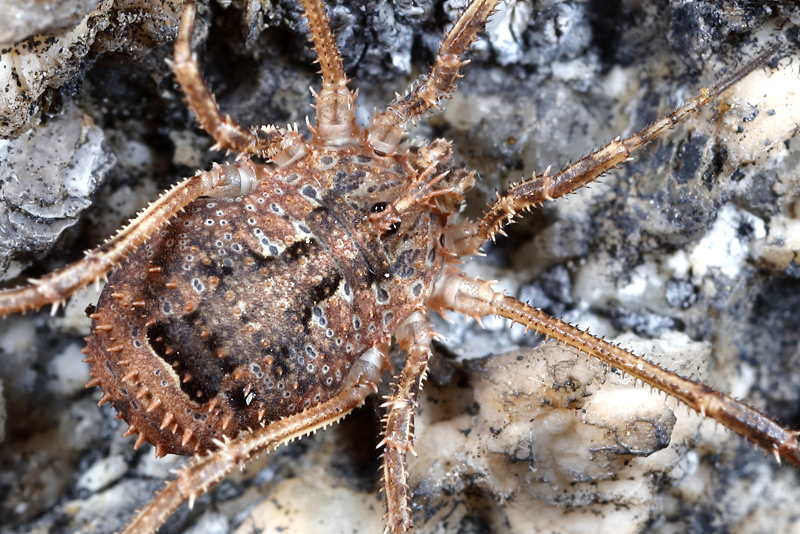
Lacinius horridus
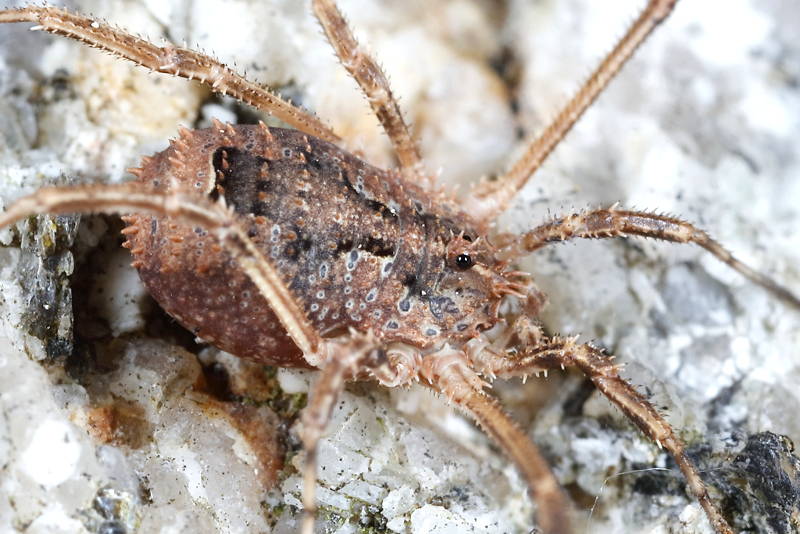
Lacinius horridus
Metaplatybunus grandissimus
Metaplatybunus grandissimus is a sturdy-looking harvestman with thick legs that have rows of black teeth. It is a rare species in Bulgaria. I found this harvestman on the trunk of a large tree, the Oriental Plane Tree Platanus orientalis.

Metaplatybunus grandissimus
Odiellus lendli
In Bulgaria I find close to a stream under a thick branch some relatively small harvestmen that me strongly reminiscent of the Odiellus spinosus from The Netherlands. It looks like they are still not mature. Now there is a problem, spinosus doesn't have that many spines and in the Checklist (Babalean,2004) only Odiellus lendli is mentioned but there is no image. A drawing of the species is in (Chemeris, 2005), so a prudent assumption that this is it. Also from Kyustendil. My identification is confirmed by Plamen Mitov.
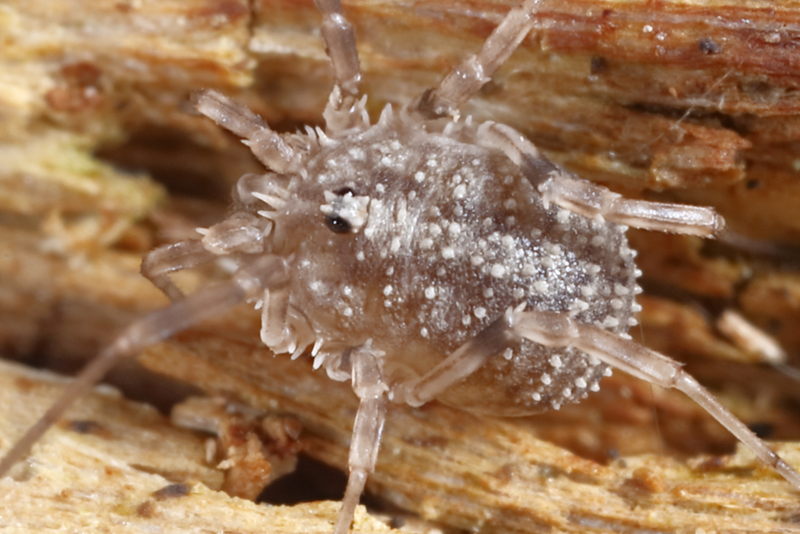
Odiellus lendli, juvenile
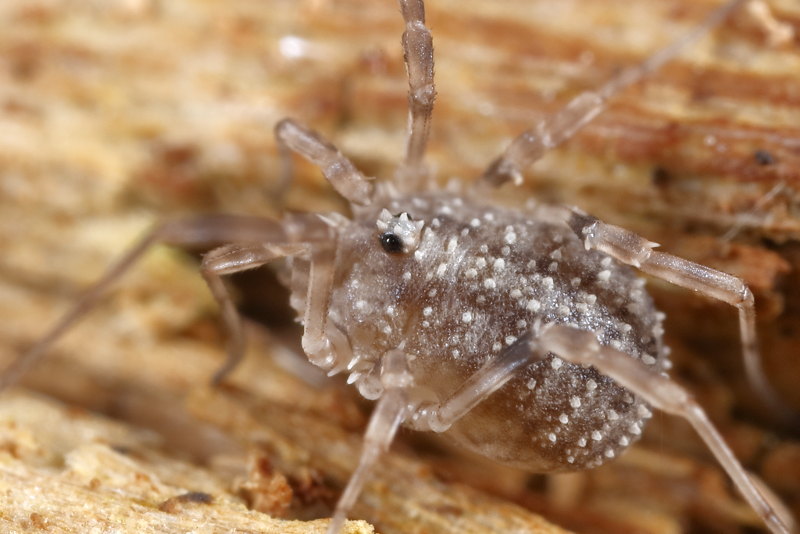
Odiellus lendli, juvenile

Odiellus lendli, juvenile

Odiellus lendli, juvenile
Opilio ruzickai
Opilio ruzickai looks a lot like the common species in The Netherlands of Opilio canestrinii with the white marks on the abdomen, but that species does not occurs in Bulgaria. The young specimen from with I've made a picture, shows clearly the white stripes and is to be recognized, despite it is not adult. Unfortunately, in June, the time I was in Bulgaria, many harvestmen are still not mature.
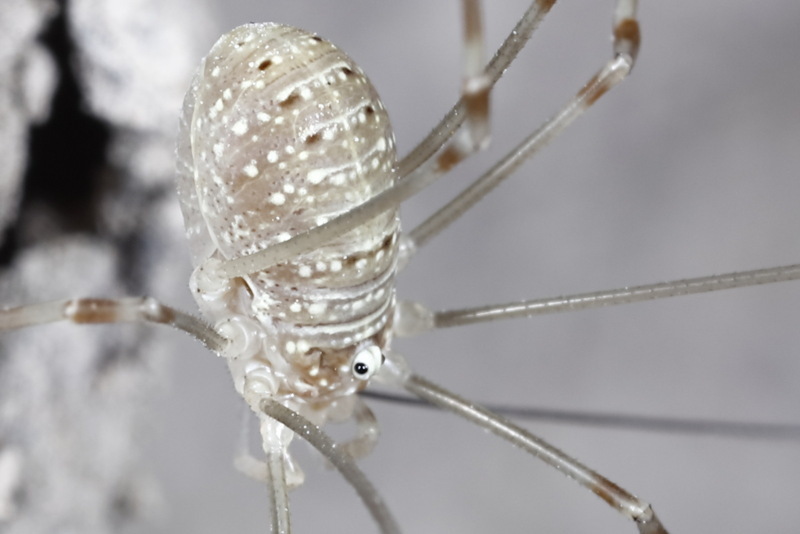
Opilio ruzickai juveniel
Opilio saxatilis
Opilio saxatilis also occurs in the Netherlands. In May/June, many harvestmen are not yet adult. Therefore, only pictures of young specimens.
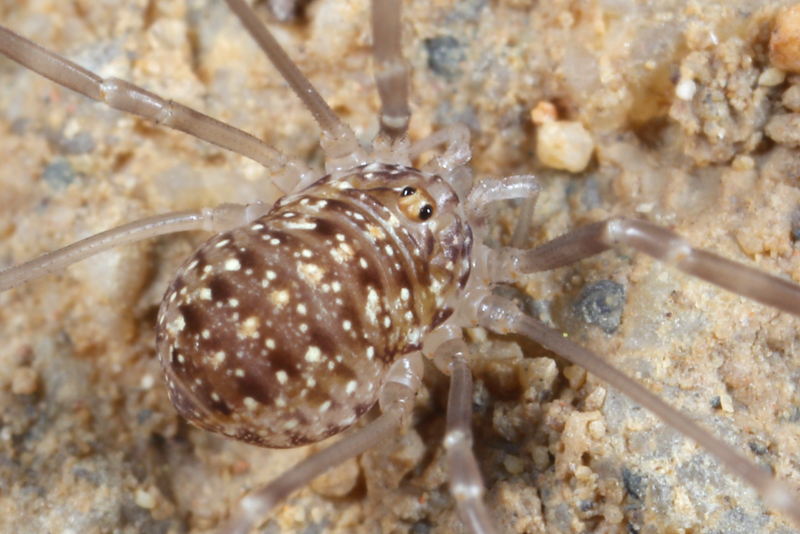
Opilio saxatilis juveniel
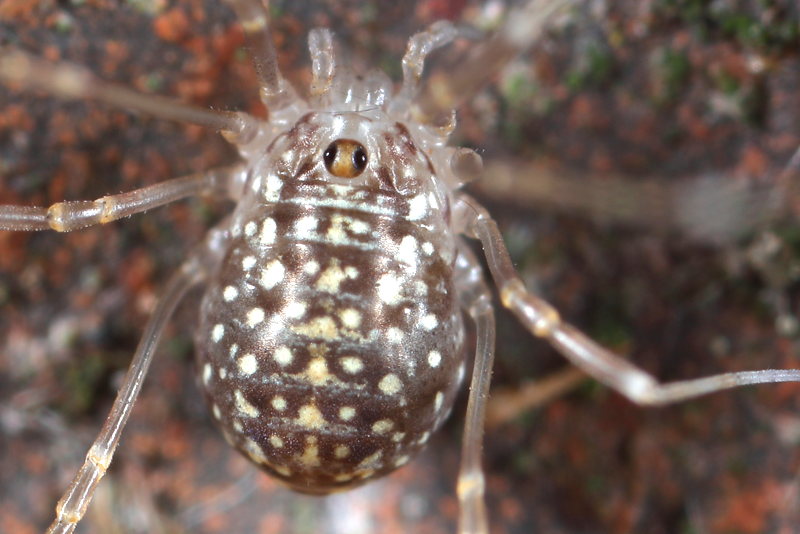
Opilio saxatilis juveniel
Rafalskia olympica bulgarica
Rafalskia olympica bulgarica looks a lot like Metaplatybunus grandissimus but the palps are clearly different. I took the photos from live specimens collected by Plamen Mitov.
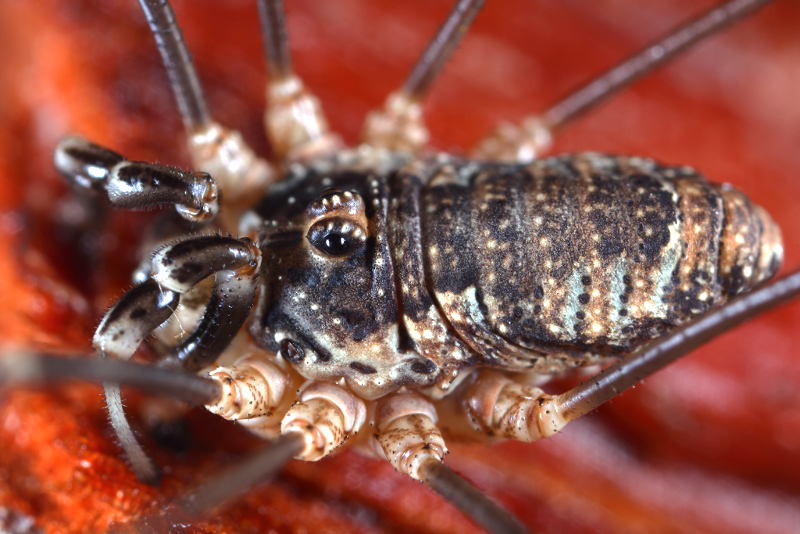
Rafalskia olympica bulgarica ♂
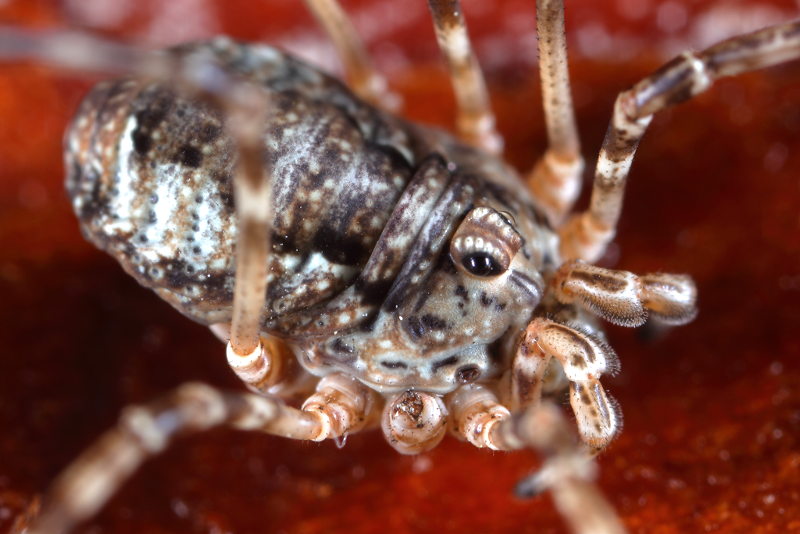
Rafalskia olympica bulgarica subadult
Zachaeus crista
During a holiday in the Czech Republic I find a very thick harvestman.The animal runs across the sand road and my first thought is: a cricket. Only as I look better I see that it is a harvestman. It is a beautiful dark brown animal with reddish back stripe. There is another species that looks like it but there the ocularium is lower and without thorns. Body length females up to 11 mm, males up to 10,5 mm. The species also occurs in Bulgaria and I find it on three places. (Identification Plamen Mitov)

Zachaeus crista
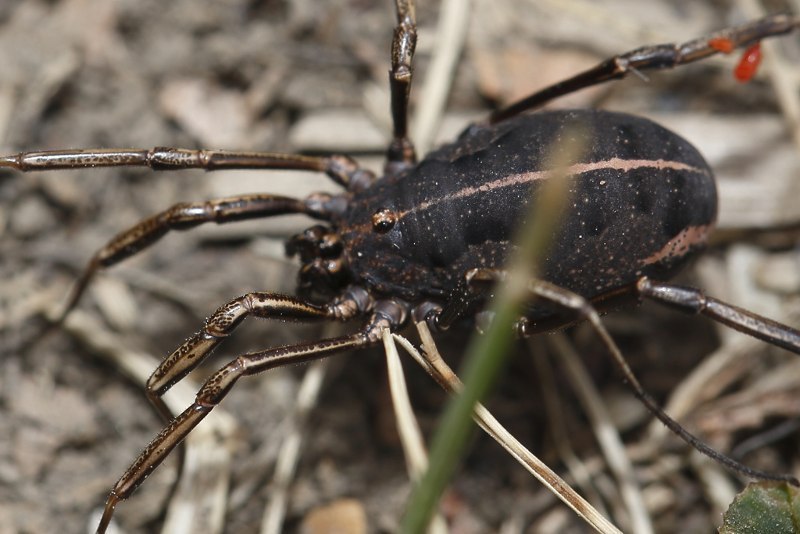
Zachaeus crista

Zachaeus crista
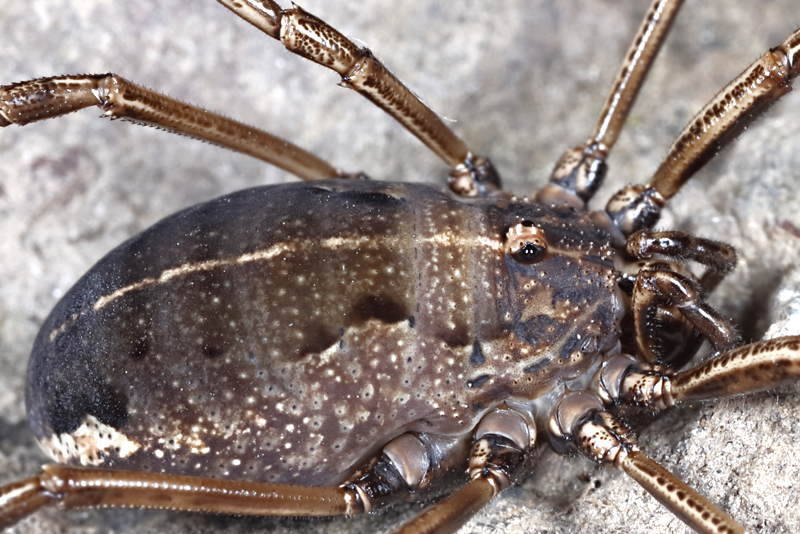
Zachaeus crista

Zachaeus crista
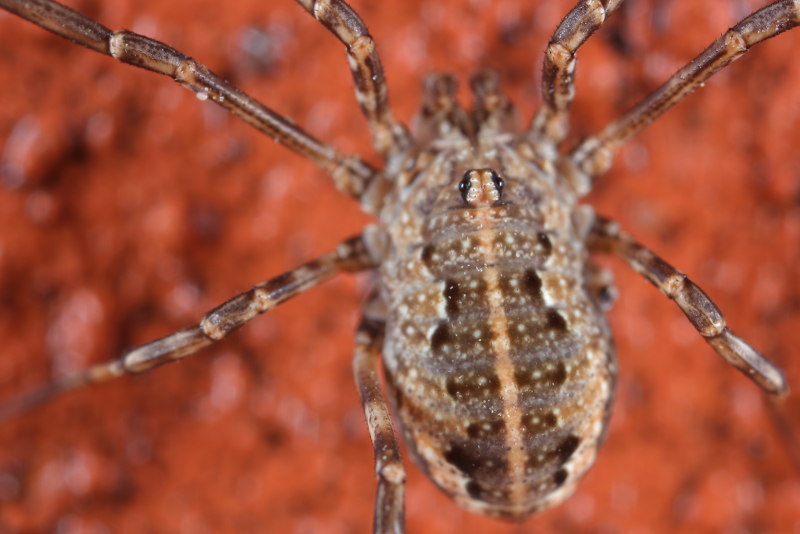
Zachaeus crista, juveniel
Thanks
I would like to thank Plamen Mitov for the identification of the animals, providing literature and for the corrections on the site. And especially for the photo models he brought with him to the very pleasant encounter in Bulgaria.
literature:
- Babalean, A.F. 2004. On the Opilionid Fauna (Arachnida, Opiliones) from the sw part of Romania. Acta Zoologica Universitatis Comenianae 46 (2): 79-86, 2004
- Chemeris, A.N. & Kovblyuk, M.M. 2005. A contribution to the knowledge of the harvestman fauna of the Crimea (Arachnida: Opiliones) Arthropoda Selecta 14 (4): 305-328, 2005 (Chemeris, A.N. & Kovblyuk, M.M. 2005) (pdf)
- Eisner, T., Kluge, A.F., Carrel, J.E., Meinwald, J. 1971. Defense of Phalangid: Liquid repellent administered by Leg Dabbing, Science 13 August 1971, volume 173, pp. 650-652. (Eisner, T., Kluge, A.F., Carrel, J.E., Meinwald, J. 1971) (pdf)
- Juberthie C. 1961 Structures des glandes odorantes et modalites d’utilisation de leur secretion chez deux opilions cyphophthalmes. Bull. Soc. Zool. France. 1961;86:106–116
- Mitov, P. & Stoyanov, I. 2004. The Harvestmen Fauna (Opiliones, Arachnida) of the City of Sofia (Bulgaria) and its Adjacent Regions. In: Ecology of the City of Sofia. Species and Communities in an Urban Environment. L. Penev, J. Niemelä, D.J. Kotze & N. Chipev (Eds.), PENSOFT Publishers. Sofia-Moscow. 319-354. (Mitov, P. & I. Stoyanov. 2004) (pdf)
- Mitov, P.G. 2008 Opiliones (Arachnida) from the Southern Dobrudzha (NE Bulgaria) and its adjacent regions. Grupo Ibérico de Aracnología (GIA) Grupo de trabajo en Aracnología de la Sociedad Entomológica Aragonesa (SEA) (Mitov, P.G. 2008) (pdf)
- Mitov, P.G. 2011 A new anophthalmous species of Paranemastoma from Bulgaria (Opiliones: Nemastomatidae) The Journal of Arachnology Vol. 39, No. 2 (2011), pp. 303-319 (Mitov, P.G. 2011)
- Raspotnig, G., Fauler, G., Leis, M., Leis, H. 2005. Chemical profiles of scent gland secretions in the Cyphophthalmid Opilionid harvestmen , Siro duricorius AND S. exilis. Journal of Chemical Ecology, Vol. 31, No. 6, June 2005. (RASPOTNIG, G. 2005) (pdf)
- Starega, W. 1976. Die Weberknechte (Opiliones, excl. Sironidae) Bulgariens. Annales zoologici, Warszawa 33(18):287–433. (Starega, W. 1976) (pdf)
- Wikipedia Cyphophthalmi Wikipedia (Engels)